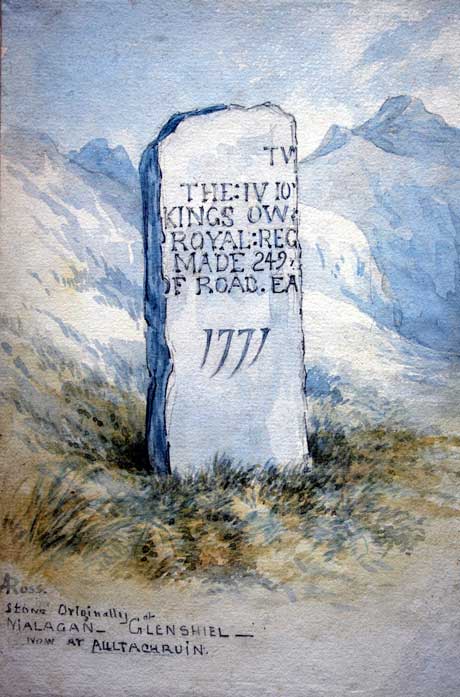 |
King's Own Royal Regiment Museum Lancaster |
|
|
HOME Museum & Collections Sales Donations Events Contact Us REGIMENTAL HISTORY 17th Century 18th Century 19th Century 20th Century First World War Second World War Actions & Movements Battle Honours FAMILY HISTORY Resources Further Reading PHOTO GALLERY ENQUIRIES FURTHER READING LINKS
© Images are copyright, Trustees of the King's Own Royal Regiment Museum. |
Collections - Paintings Road Making in the Highlands Stone showing road made by the King's Own Royal Regiment, Malagan Glensheil.
Notes on Regimental Stations on old Highland Roads, written in the 1920s. The stone shown on the sketch by Alexander Ross, LL.D., was originally place on the line of Road from Fort Augustus to Glenshiel in Kintail - a few miles East of the present hotel at the head of Loch Duich and was intended to mark the portions of the Road made by the different Regiments. This practice was usual in other parts of the Highlands when the Military were employed in making roads and Dr. Johnston mentions in his journey through Glenmoriston in 1773 that he passed parties of soldiers engaged on these roads. The old Military Road on which this and other stones were found, is now disused except by pedestrians - it leads from Fort Augustus directly over the Hill into Glenmoriston. The modern Road branches off from Loch Ness at the Moirston Bridge, and runs directly up the Valley of the Moriston all the way to Glenshiel, and generally on the North side of the old Road, which latter keeps the higher ground. The Stone marked XXX Regiment is still in situ and is 1.5 miles East of the Hotel above referred to. The Stone set up by the King's Own Royal Regiment originally stood a Malagan a few miles further up the Glen and being a handsome Stone, it was carried off by a Kintail Crofter about 50 years ago to form a Lintel in his house in a village called Aultachruin where it still remains. Being however now out of the building and used as a stand for wash-tubs. Sometime ago, at the writer's suggestion an attempt was made to get it replace in its original position (which is quite well known) but since, attention has been drawn to it a number of archaeologists and others have visited and inspected it, and so given the women (who now occupies the house) such an exaggerated idea of its value that she refuses to part with it, except at a high price, and consequently nothing has been done. The stone has been chipped to fit the Cotter's requirements and so part of the inscription has disappeared. There is, however, enough remaining to identify it.
© Images are copyright, Trustees of the King's Own Royal Regiment Museum. Only a proportion of our collections are on display at anyone time. Certain items are on loan for display in other institutions. An appointment is required to consult any of our collections which are held in store. |

